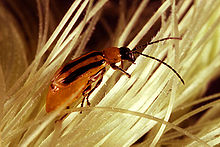- Diabrotica
-
Diabrotica 
Scientific classification Kingdom: Animalia Phylum: Arthropoda Class: Insecta Order: Coleoptera Family: Chrysomelidae Subfamily: Galerucinae Tribe: Luperini Genus: Diabrotica
Chevrolat in Dejean, 1836 [1]Species Diabrotica balteata
Diabrotica barberi
Diabrotica beniensis
Diabrotica cristata
Diabrotica curvipustulata
Diabrotica dissimilis
Diabrotica elegantula
Diabrotica emorsitans
Diabrotica graminea
Diabrotica hispanolae
Diabrotica lemniscata
Diabrotica linsleyi
Diabrotica longicornis
Diabrotica milleri
Diabrotica nummularis
Diabrotica occlusa
Diabrotica porracea
Diabrotica scutellata
Diabrotica speciosa
Diabrotica tibialis
Diabrotica trifasciata
Diabrotica undecimpunctata
Diabrotica virgifera
Diabrotica viridulaDiabrotica is a widespread genus of beetles, sometimes referred to as cucumber beetles or corn rootworms, in the family Chrysomelidae. Members of this genus include several destructive agricultural pest species.
Contents
Range
Corn rootworms are one of the most economically destructive insects of maize in the United States. The Western corn rootworm, D. virgifera virgifera, and the Northern corn rootworm, D. barberi, are the most devastating rootworm species in Iowa, a major corn-growing area. A third species, the Southern corn rootworm, D. undecimpunctata howardi, causes much economic damage in other regions. Corn rootworm larvae can destroy significant percentages of corn if left untreated. In the United States, current estimates show that 30 million acres (120,000 km²) of corn, out of 80 million acres (320,000 km²) grown, are infested with corn rootworms and the number of infested acres is expected to grow over the next 20 years. The United States Department of Agriculture estimates that corn rootworms cause $1 billion in lost revenue each year, which includes $800 million in yield loss and $200 million in cost of treatment for corn growers (The Dow Chemical Company).
Diabrotica was unknown in European countries until the late 1990s and was forbidden even in laboratories because of the difficulty in eliminating it with known chemical insecticides if it escaped. It appears to have entered Europe from the United States in large numbers during the Yugoslav wars and is especially widespread around U.S. military airports, whose planes were likely to have carried the pest. It has since spread primarily in Italy, France, and Germany.
Species
Several species of Diabrotica are significant pests in North America. They include:
- Banded cucumber beetle, Diabrotica balteata
- Northern corn rootworm, Diabrotica barberi
- Spotted cucumber beetle (a.k.a. Southern corn rootworm), Diabrotica undecimpunctata howardi
- Western cucumber beetle, Diabrotica undecimpunctata tenella
- Western spotted cucumber beetle, Diabrotica undecimpunctata undecimpunctata
- Western corn rootworm, Diabrotica virgifera virgifera
- Mexican corn rootworm, Diabrotica virgifera zeae
Diabrotica undecimpunctata
Main article: Diabrotica undecimpunctataAdults of D. undecimpunctata are greenish-yellow with six large black spots on each elytron. They are about half a centimeter long. The larvae are yellowish and wormlike. D. undecimpunctata comprises three subspecies — Diabrotica undecimpunctata howardi (Southern corn rootworm or spotted cucumber beetle), Diabrotica undecimpunctata tenella (Western cucumber beetle) and Diabrotica undecimpunctata undecimpunctata (Western spotted cucumber beetle).
Diabrotica virgifera
Main article: Diabrotica virgiferaAdult rootworms are about 1/4 inch long. Western corn rootworms are yellowish with a black stripe on each wing cover. Northern corn rootworm beetles are solid in color and vary from light tan to pale green (Wright). The eggs are deposited in the soil during the summer, and are football-shaped, white, and less than 0.004 inches long. Larvae hatch in late May or early June and begin to feed on corn roots. Newly hatched larvae are small, less than 1/8 inch long, white worms. Corn rootworms go through three larval instars, pupate in the soil, and emerge as adults in July and August. There is one generation per year. Larvae have brown heads and a brown marking on the top of the last abdominal segment, giving them a double-headed appearance. Larvae have three pairs of legs, but these are not usually visible without magnification. After feeding for several weeks, the larvae dig a cell in the soil and molt into the pupal stage. The pupal stage is white and has the basic shape of the adult.
References
- ^ "Diabrotica". Integrated Taxonomic Information System. http://www.itis.gov/servlet/SingleRpt/SingleRpt?search_topic=TSN&search_value=719674.
General references
- R. Wright, L. Meinke & K. Jarvi (July 1999). "Corn Rootworm Management". University of Nebraska. http://ianrpubs.unl.edu/insects/ec1563.htm. Retrieved 2007-02-03.
External links
- banded cucumber beetle on the UF / IFAS Featured Creatures Web site
Categories:- Chrysomelidae
- Agricultural pest insects
- Maize
Wikimedia Foundation. 2010.
